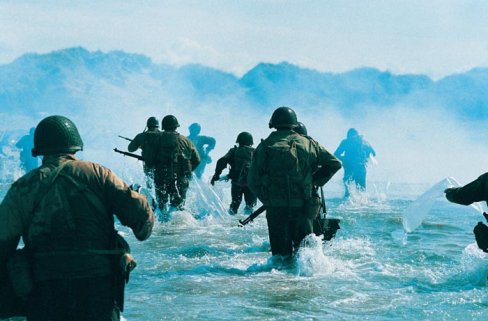
The Normandy Landings were the first operation of the Allied invasion of Normandy, also known as Operation Neptune and Operation Overlord, during World War II. D-Day for the operation, postponed 24 hours, became June 6, 1944, H-Hour was 6:30 am. The assault was conducted in two phases: an air assault landing of American, British and Canadian airborne troops shortly after midnight, and an amphibious landing of Allied infantry and armoured divisions on the coast of France commencing at 06:30 British Time. It required the transport of soldiers and materiel from the United Kingdom by troop carrying aircraft and ships, the assault landings, air support, naval interdiction of the English Channel and naval fire-support. There were also subsidiary operations to distract the Kriegsmarine and prevent its interference in the landing areas.
The operation was the largest single-day invasion of all time, with over 130,000 troops landed on June 6, 1944. 195,700 Allied naval and merchant navy personnel were involved. The landings took place along a stretch of the Normandy coast divided into five sectors: Utah, omaha, Gold, Juno and Sword. The success of the amphibious landings depended on the establishment of a secure lodgment from which to expand the beachhead to allow the build up of a well-supplied force capable of breaking out. The amphibious forces were especially vulnerable to strong enemy counterattacks before the build up of sufficient forces in the beachhead could be accomplished. To slow or eliminate the enemy’s ability to organize and launch counterattacks during this critical period, airborne operations were used to seize key objectives, such as bridges, road crossings, and terrain features, particularly on the eastern and western flanks of the landing areas.
The airborne landings some distance behind the beaches were also intended to ease the egress of the amphibious forces off the beaches, and in some cases to neutralize German coastal defence batteries and more quickly expand the area of the beachhead. The U.S. 82nd and 101st Airborne Divisions were assigned to objectives west of Utah Beach. The British 6th Airborne Division was assigned to similar objectives on the eastern flank. 500 Free French paratroopers from the British Special Air Service Brigade (S.A.S.) were assigned to objectives in Brittany from June 6 to August.
"The Normandy invasion"[http://www.worldwar2database.com/html/normandy.htm]
"Normandy Invasion"[http://www.history.navy.mil/photos/events/wwii-eur/normandy/normandy.htm]
"The d-day Landing"[http://www.history.navy.mil/photos/events/wwii-eur/normandy/nor4.htm]




No comments:
Post a Comment